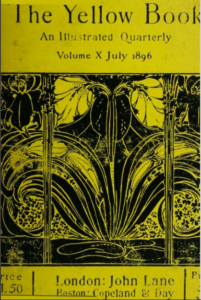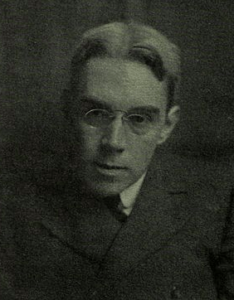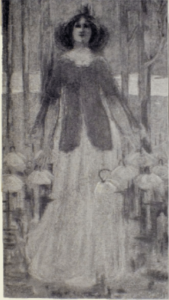Support of New Woman Ideology in “The Invisible Prince” and The Yellow Book, Volume 10
© Copyright 2017 Olivia Moore, Ryerson University

The publication of “The Invisible Prince”, and the tenth volume of The Yellow Book in general, coincides with changing societal values concerning women’s roles within 1890s British society that emerged during the 1830s Suffragette Movement. The independent female character within Henry Harland’s “The Invisible Prince” shares many of the attributes related to the idea of the New Woman that became widely recognized through literature during the Victorian Era. This exhibit will examine whether 1890s societal views of women are supported or contrasted within the tenth volume of The Yellow Book, and more specifically Henry Harland’s “The Invisible Prince”. As a result, this will help to contextualize the evolving role of women within Victorian society, and how The Yellow Book may be indicative and even influential of these changes.
HENRY HARLAND

It is first important to recognize that Henry Harland, the author of “The Invisible Prince”, became the editor of The Yellow Book in 1894 (“Harland, Henry”). The tenth volume of The Yellow Book was published in 1896, two years after Harland earned the position of editor. As the editor of The Yellow Book, Harland possessed an extremely influential role in determining which pieces were published within the periodical. Historically throughout the 1890s, many female poets, even a few that were published within The Yellow Book, were New Women who immersed themselves within the working world outside of the domestic sphere (Hughes 850). It is argued that Harland’s “journal of art and literature was an important conduit for women writers at the fin de siècle,” (Ledger 6), which further illustrates the role he played in promoting and supporting female writers and New Woman literature. Harland’s “The Invisible Prince” highlights the idea of the New Woman and supports the involvement of many female contributors to The Yellow Book who were New Women themselves. Therefore, analyzing those who contributed pieces to the tenth volume of The Yellow Book, and worked in editing and publishing, can provide insight toward the beliefs that are perpetuated in this periodical.
NEW WOMAN FICTION & “THE INVISIBLE PRINCE”
The female character within “The Invisible Prince” represents many characteristics of the New Woman within the 1890s through her bold and independent behaviour. It is interesting to note that at the beginning of the story it is the woman who first approaches Mr. Field and initiates conversation instead of Mr. Field approaching her. This type of action was extremely unconventional in Victorian Era culture. By introducing herself this way, the woman immediately displays the boldness and nonconformity of her character. Additionally, this anonymous woman does not seem to be accompanied at the masquerade. This suggests her as attending independently, which although society’s perceptions towards women were changing, women attending these types events alone was still uncommon. In Feminist Studies, Weber states, “It was particularly in the decade of the 1890s, for instance, that educated ‘New Woman’ were charged with having become ‘unsexed’ for seeking professional and public lives that put them in the hurly-burly of the masculinized marketplace,” (Weber 548). This indicates a major shift in ideology towards women’s roles within society that is observed within the mannerisms of the female character in “The Invisible Prince”. As women began to seek lives outside of the domestic sphere, opinions and perceptions concerning the education of women began to change. In order to be considered equal to men, women began searching for better opportunities in education that would result in improved employment opportunities. In “The Invisible Prince”, Mr. Field observes that his female counterpart has, “enjoyed a liberal education,” (Harland 70). Even before discovering her physical appearance, Mr. Field becomes attracted to the woman because of the sharp wit and intellect the woman developed through education. This appreciation of the educated female speaks to the new beliefs surrounding education witnessed in society during the 1890s. It also presents an extremely crucial quality that classifies the female character as a New Woman seeing as New Woman Fiction presented a demand for improved academic and employment opportunities for women (“New Woman Fiction”). However, these are not the sole manners in which the unnamed female character represents the New Woman. The New Woman is additionally described as, “questioning traditional attitudes towards marriage,” (“New Woman Fiction”). The female character in “The Invisible Prince” expertly avoids accepting or explicitly declining a marriage proposal when Mr. Field asks her to marry him. She chooses to take time to consider the proposal instead of immediately accepting it (Harland 87). Through this act of contemplation, the reader is able to observe this woman’s consideration for her own independence and her ability to make informed decisions. It is evident that she is successful as an individual and did not rely on a man to ensure her success. In avoiding directly answering the request for marriage, the woman ensures that she gives herself time to contemplate whether marriage will be an overall beneficial alteration to the life that she has already established for herself. This therefore provides another example of how the anonymous female character within “The Invisible Prince” illustrates the attributes of the “New Woman” by demonstrating her autonomy in creating her own success, and displaying her autonomy in choosing whether she wants to share that success with another individual. Literature that supported the idea of the New Woman typically wrote about the notion of working women who lived independently (Hughes 851). This idea of the employed single woman emerges within “The Invisible Prince”, thus reflecting the shift in ideology towards women’s roles in society that was occurring during the time of publication of The Yellow Book: Volume X.
ARTWORK
Another aspect of the tenth volume of The Yellow Book that supports female independence and rights can be observed within its artwork. Nine out of the thirteen pieces of artwork feature women independent of men. Additionally, three out of the thirteen pieces feature bare-breasted

women, depicting less conventional ideas of modesty and sexual expression. Some of the pieces such as “A Dutch Woman” represent women within the workplace, or working within the home (Forbes 7). Whether choosing to capture these women working within or outside of the domestic sphere, these pieces portray the determination and dedication of working women during the 1890s. They emphasize the responsibilities that these women were tasked with keeping and in ensuring these responsibilities were kept, proved that they could complete tasks in an equal capacity to men. Other pieces such as Macdonald’s “A Dream” and Cameron’s “The Butterflies” sketch women within natural environments and include details that suggest somewhat supernatural elements. Whether viewing the ethereality of the butterflies within Cameron’s sketch or the sublime physical appearance of the woman in Macdonald’s drawing, both instill viewers with a sense of being within nature and yet witnessing something that transcends beyond the natural simultaneously. This strong focus on women both within the home, the working world, natural and even unnatural environments is crucial as it presents the diversity within women’s capabilities to exist in different facets of life in a similar fashion to how men were able to have lives both inside and outside of the home. Hence, the artwork presented within this periodical further supports that The Yellow Book was in favour of female individuality, expression and independence.
REVIEWS & PUBLIC OPINION
Several reviews of the tenth volume of The Yellow Book, and “The Invisible Prince” in particular, also help contextualize how The Yellow Book was received in society at its time of publication. These reviews provide further insight toward the public’s stance on the New Woman and the roles of women in general. A review from the National Observer states that, “‘The Invisible Prince’ of Henry Harland is quite the best of many diverting stories, for all the too exceeding cleverness of its dialogue,” (“Yellow and Green”). This excerpt highlights the intelligence of the female character as much of the witty dialogue in “The Invisible Prince” is spoken by her. She delivers this dialogue with same degree of thought and sharp wit as the character of Mr. Fields. The National Observer is a national newspaper that, through its reviews, provides a general sense of British society’s perspective on certain subjects. Therefore, this review gives insight toward the positive manner in which society regarded “The Invisible Prince” by meriting it as the best story within the tenth volume of The Yellow Book, further presenting an appreciation for the intellectual and independent female. Other reviews have reported The Yellow Book as being “better worth its price than most books of other colours,” (Zangwill) and directly mentions and praises Harland’s “The Invisible Prince.” This serves as more proof of the ideologies and themes present within “The Invisible Prince” being reflected in society’s changing perceptions towards women’s rights.
SUPPORT OF NEW WOMAN IDEOLOGY
Overall, the tenth volume of The Yellow Book consists of literature, poetry and artwork that reflect changing societal conventions in terms of women’s roles during the 1890s. The Yellow Book provided writers, and female writers especially, that sought to publish pieces concerning the idea of the New Woman with a medium in which to publish their work. Ella D’Arcy, a writer published within The Yellow Book who became both an editorial assistant and deputy editor of The Yellow Book, has reported The Yellow Book as incorporating a high degree of involvement of female writers and artists (Ledger 8). Through providing this kind of exposure to New Woman Literature, and giving these opportunities to female writers, The Yellow Book, although generally regarded as avant-garde, was able to play an influential role in shifting societal conceptions of women’s roles. By involving women not only as authors and artists, but as editors to The Yellow Book proves a demonstration of the New Woman in reality that is perpetuated through the literature within the periodical. In regards to Harland’s “The Invisible Prince”, as the unnamed woman is single, employed, educated, intellectual, bold and independent, she successfully represents the new emerging ideology concerning female identity within the 1890s and therefore supports changing societal perspectives towards women’s roles during the Victorian Era.
Works Cited
Cameron, DY. “The Butterflies.” The Yellow Book 10 (July 1896): 220. The Yellow Nineties Online. Ed. Dennis Denisoff and Lorraine Janzen Kooistra. Ryerson University.
Forbes, Elizabeth Stanhope. “A Dutch Woman.” The Yellow Nineties Online. Ed. Dennis Denisoff and Lorraine Janzen Kooistra. Ryerson Universtiy.
Harland, Henry. “The Invisible Prince.” The Yellow Book, vol. 10, John Lane, 1896, London, pp. 59-87.
“Harland, Henry.” The Oxford Companion to English Literature. Ed. Birch, Dinah. Oxford University Press, 2009. Oxford Reference. 2009. Date Accessed 13 Nov. 2017
Hughes, Linda K. “Women Poets and Contested Spaces in The Yellow Book.” SEL Studies in English Literature 1500-1900, vol. 44, no. 4, 2004, pp. 849-872.
Ledger, Sally. “Wilde Women and The Yellow Book: The Sexual Politics of Aestheticism and Decadence”. English Literature in Transition, 1880-1920, vol. 50, no. 1, 2007, pp. 5-26.
Macdonald, Margaret. “A Dream.” The Yellow Book 10 (July 1896): 163. The Yellow Nineties Online. Ed. Dennis Denisoff and Lorraine Janzen Kooistra. Ryerson University.
“New Woman fiction.” The Oxford Companion to English Literature. Ed. Birch, Dinah. Oxford University Press, 2009. Oxford Reference. 2009. Date Accessed 18 Nov. 2017
Weber, Brenda R. “‘Were Not These Words Conceived in Her Mind?’ Gender/Sex and Metaphors of Maternity at the Fin De Siècle.” Feminist Studies, vol. 32, no. 3, 2006, pp. 547–572
“Yellow and Green.” National Observer, Ed. Dennis Denisoff and Lorraine Janzen Kooistra, The Yellow Nineties Online, Ryerson University, 2010.
Zangwill, I. Rev. of The Yellow Book 10. Ed. Dennis Denisoff and Lorraine Janzen Kooistra, Pall Mall Magazine, The Yellow Nineties Online, Ryerson University, 2010.
